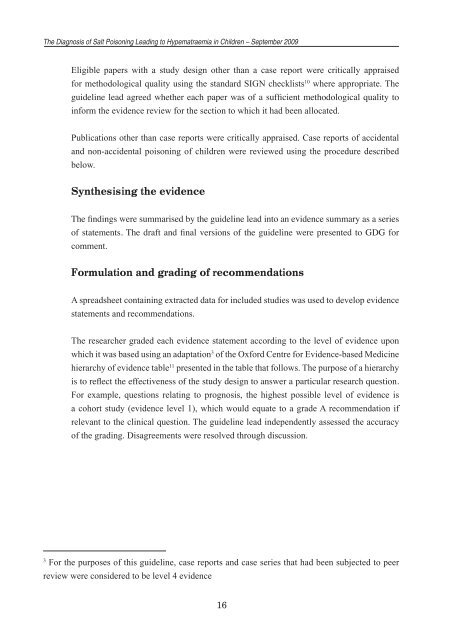The differential diagnosis of hypernatraemia in children, with ...
The differential diagnosis of hypernatraemia in children, with ...
The differential diagnosis of hypernatraemia in children, with ...
Create successful ePaper yourself
Turn your PDF publications into a flip-book with our unique Google optimized e-Paper software.
<strong>The</strong> Diagnosis <strong>of</strong> Salt Poison<strong>in</strong>g Lead<strong>in</strong>g to Hypematraemia <strong>in</strong> Children – September 2009<br />
Eligible papers <strong>with</strong> a study design other than a case report were critically appraised<br />
for methodological quality us<strong>in</strong>g the standard SIGN checklists 10 where appropriate. <strong>The</strong><br />
guidel<strong>in</strong>e lead agreed whether each paper was <strong>of</strong> a sufficient methodological quality to<br />
<strong>in</strong>form the evidence review for the section to which it had been allocated.<br />
Publications other than case reports were critically appraised. Case reports <strong>of</strong> accidental<br />
and non-accidental poison<strong>in</strong>g <strong>of</strong> <strong>children</strong> were reviewed us<strong>in</strong>g the procedure described<br />
below.<br />
Synthesis<strong>in</strong>g the evidence<br />
<strong>The</strong> f<strong>in</strong>d<strong>in</strong>gs were summarised by the guidel<strong>in</strong>e lead <strong>in</strong>to an evidence summary as a series<br />
<strong>of</strong> statements. <strong>The</strong> draft and f<strong>in</strong>al versions <strong>of</strong> the guidel<strong>in</strong>e were presented to GDG for<br />
comment.<br />
Formulation and grad<strong>in</strong>g <strong>of</strong> recommendations<br />
A spreadsheet conta<strong>in</strong><strong>in</strong>g extracted data for <strong>in</strong>cluded studies was used to develop evidence<br />
statements and recommendations.<br />
<strong>The</strong> researcher graded each evidence statement accord<strong>in</strong>g to the level <strong>of</strong> evidence upon<br />
which it was based us<strong>in</strong>g an adaptation 3 <strong>of</strong> the Oxford Centre for Evidence-based Medic<strong>in</strong>e<br />
hierarchy <strong>of</strong> evidence table 11 presented <strong>in</strong> the table that follows. <strong>The</strong> purpose <strong>of</strong> a hierarchy<br />
is to reflect the effectiveness <strong>of</strong> the study design to answer a particular research question.<br />
For example, questions relat<strong>in</strong>g to prognosis, the highest possible level <strong>of</strong> evidence is<br />
a cohort study (evidence level 1), which would equate to a grade A recommendation if<br />
relevant to the cl<strong>in</strong>ical question. <strong>The</strong> guidel<strong>in</strong>e lead <strong>in</strong>dependently assessed the accuracy<br />
<strong>of</strong> the grad<strong>in</strong>g. Disagreements were resolved through discussion.<br />
3<br />
For the purposes <strong>of</strong> this guidel<strong>in</strong>e, case reports and case series that had been subjected to peer<br />
review were considered to be level 4 evidence<br />
16

















